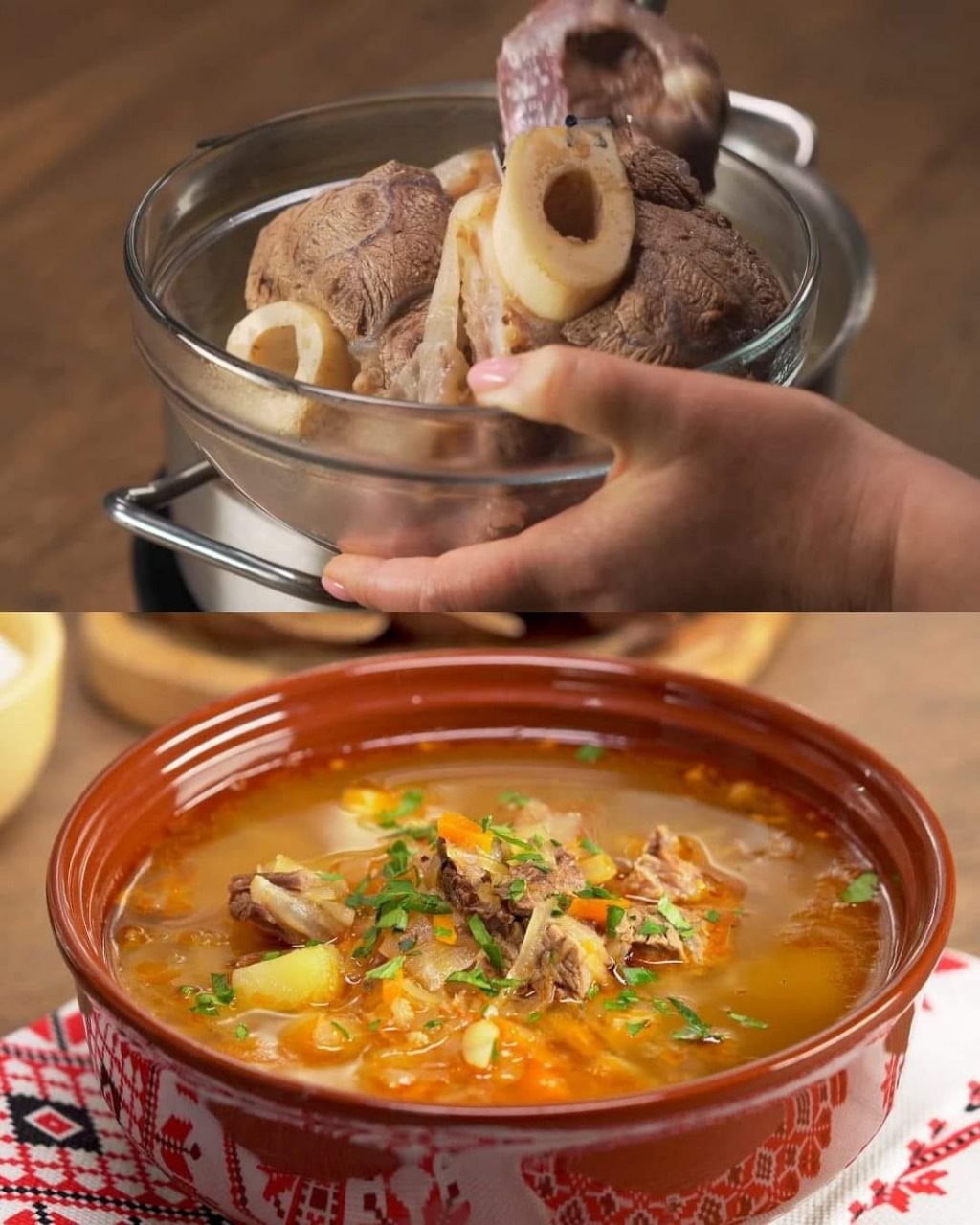ADVERTISEMENT
Step 1: Prepare the Broth
Boil the Beef:
Place the beef on the bone in a large pot. Add 3 liters of water and bring to a boil.
As the water heats, skim off any foam or impurities that rise to the surface.
Simmer:
Once boiling, reduce the heat to low and let the beef simmer for about 1.5-2 hours. This slow cooking helps extract all the flavors from the beef and bones, creating a rich broth.
Strain and Set Aside:
After the beef is fully cooked, remove it from the pot. Strain the broth and set aside. You can remove the meat from the bone and set it aside for later use in the soup.
Step 2: Prepare the Vegetables
Prepare the Sauerkraut:
If the sauerkraut is too sour, rinse it under cold water to reduce the acidity. Drain well and set aside.
Chop the Vegetables:
Peel and chop the carrots, onions, and potatoes into bite-sized pieces. Mince the garlic and chop the parsley.
Step 3: Sauté the Vegetables
Sauté Onions and Carrots:
Heat 3 tablespoons of vegetable oil in a large skillet over medium heat. Add the chopped onions and carrots, sautéing until softened and lightly golden, about 5-7 minutes.
Add Tomato Paste:
Stir in the tomato paste and cook for an additional 2 minutes to release its flavor.
Step 4: Combine Everything in the Pot
Add Vegetables to the Broth:
Add the sautéed onions and carrots to the strained beef broth. Then, add the sauerkraut and potatoes to the pot. Stir well.
Simmer:
Bring the soup to a boil, then reduce the heat and let it simmer for about 30-40 minutes until the potatoes are tender and the flavors meld together.
Add the Beef:
Shred the cooked beef and add it back into the pot. Stir in the minced garlic, black pepper, and chopped parsley. Adjust the salt to taste.
Step 5: Serve the Soup
Once everything is cooked, remove the pot from heat and let the soup rest for about 10 minutes before serving. Serve hot, garnished with extra parsley, alongside a slice of crusty bread or a dollop of sour cream for added richness.
Cooking Tips
Adjusting the Sourness: If your sauerkraut is too sour for your liking, feel free to rinse it under cold water before adding it to the soup. You can control the tanginess by adjusting the amount of sauerkraut or adding a little sugar to balance the acidity.
Using Pork: If you prefer, you can substitute the beef with pork. Pork adds a slightly sweeter, richer flavor to the broth.
Tomato Paste: For a deeper flavor, allow the tomato paste to sauté for a few minutes until it slightly darkens in color, bringing out its natural sweetness.
Add Some Heat: If you enjoy a bit of spice, feel free to add a pinch of red pepper flakes or a finely chopped chili pepper.
Storage
Refrigeration: Store leftover shchi in an airtight container in the fridge for up to 4-5 days. The flavors of the soup improve as it sits, making it even more delicious the next day!
Freezing: Shchi freezes well! Transfer the cooled soup to freezer-safe containers or bags and freeze for up to 3 months. Thaw in the fridge overnight before reheating.
Nutritional Facts (Per Serving)
This is based on dividing the recipe into 6 servings.
Calories: 320 kcal
Protein: 22 g
Carbohydrates: 25 g
Fat: 15 g
Saturated Fat: 5 g
Fiber: 4 g
Sodium: 1000 mg
Sugar: 7 g
FAQs
1. What is shchi?
Shchi is a traditional Russian soup made with either fresh or fermented cabbage. Sauerkraut shchi is the most popular version, known for its tangy, hearty flavor.
2. Can I make shchi without meat?
Yes, you can make a vegetarian version of shchi by omitting the meat and using vegetable broth instead. Add extra potatoes, beans, or mushrooms to bulk it up.
3. Can I use fresh cabbage instead of sauerkraut?
While sauerkraut gives this dish its signature tangy flavor, you can substitute it with fresh cabbage. Simply shred the cabbage and add it in place of the sauerkraut. The flavor will be milder, so you may want to add a splash of vinegar or lemon juice for acidity.
4. What can I serve with shchi?
Shchi is often served with sour cream, fresh herbs, and rye bread on the side. Some people also enjoy a dollop of mustard for an extra kick.
5. How can I thicken my soup?
If you prefer a thicker soup, you can mash some of the potatoes after they’re cooked or add a little flour or cornstarch slurry to the broth to thicken it up.
Conclusion
Sauerkraut Shchi is a wonderful soup for anyone who enjoys bold flavors and hearty ingredients. This classic Russian recipe combines the richness of beef, the tang of sauerkraut, and the earthiness of root vegetables to create a comforting and filling meal. It’s not only perfect for warming up on a cold day but also serves as a nutritious dish that’s easy to prepare. Whether you’re new to Russian cuisine or simply looking for a satisfying soup to add to your repertoire, this sauerkraut shchi is a must-try. Enjoy this timeless dish with your loved ones and savor the delicious flavors that have been cherished for generations.
